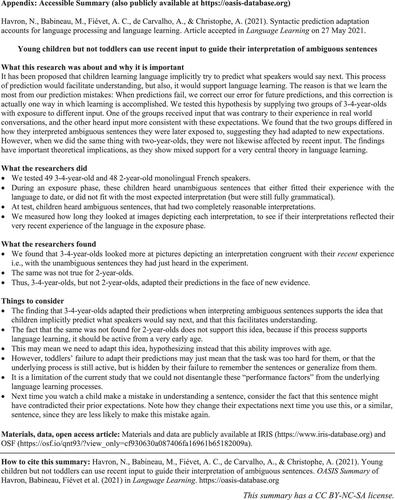当前位置:
X-MOL 学术
›
Lang. Learn.
›
论文详情
Our official English website, www.x-mol.net, welcomes your feedback! (Note: you will need to create a separate account there.)
Syntactic Prediction Adaptation Accounts for Language Processing and Language Learning
Language Learning ( IF 5.240 ) Pub Date : 2021-07-13 , DOI: 10.1111/lang.12466 Naomi Havron 1, 2 , Mireille Babineau 1, 3 , Anne‐Caroline Fiévet 1 , Alex Carvalho 1, 4 , Anne Christophe 1
Language Learning ( IF 5.240 ) Pub Date : 2021-07-13 , DOI: 10.1111/lang.12466 Naomi Havron 1, 2 , Mireille Babineau 1, 3 , Anne‐Caroline Fiévet 1 , Alex Carvalho 1, 4 , Anne Christophe 1
Affiliation

|
A previous study has shown that children use recent input to adapt their syntactic predictions and use these adapted predictions to infer the meaning of novel words. In the current study, we investigated whether children could use this mechanism to disambiguate words whose interpretation as a noun or a verb is ambiguous. We tested 2- to 4-year-old French children using the phrase la petite followed by a homophone that could be interpreted as either a noun or a verb. We assigned the children to a noun condition or a verb condition. Before the test, those in the noun condition were exposed to sentences where la petite predicted nouns, and those in the verb condition to sentences where la petite predicted verbs. At testing, 3- to 4-year-olds, but not 2-year-olds, from the verb condition looked at the verb interpretation longer than did the children in the noun condition. This suggests a progression in children's ability to rely on input to adapt their predictions in language comprehension.
中文翻译:

语言处理和语言学习的句法预测适应帐户
先前的一项研究表明,儿童使用最近的输入来调整他们的句法预测,并使用这些调整后的预测来推断新词的含义。在目前的研究中,我们调查了儿童是否可以使用这种机制来消除作为名词或动词的解释不明确的单词。我们使用短语la petite后跟可以解释为名词或动词的同音字来测试 2 至 4 岁的法国儿童。我们将孩子分配给名词条件或动词条件。考试前,名词条件的人接触la petite预测名词的句子,动词条件的人接触la petite预测名词的句子。预测动词。在测试中,3 到 4 岁的孩子,但不是 2 岁的孩子,从动词条件看动词解释的时间比在名词条件下的孩子要长。这表明儿童依靠输入来调整他们对语言理解的预测的能力有所提高。
更新日期:2021-07-13
中文翻译:

语言处理和语言学习的句法预测适应帐户
先前的一项研究表明,儿童使用最近的输入来调整他们的句法预测,并使用这些调整后的预测来推断新词的含义。在目前的研究中,我们调查了儿童是否可以使用这种机制来消除作为名词或动词的解释不明确的单词。我们使用短语la petite后跟可以解释为名词或动词的同音字来测试 2 至 4 岁的法国儿童。我们将孩子分配给名词条件或动词条件。考试前,名词条件的人接触la petite预测名词的句子,动词条件的人接触la petite预测名词的句子。预测动词。在测试中,3 到 4 岁的孩子,但不是 2 岁的孩子,从动词条件看动词解释的时间比在名词条件下的孩子要长。这表明儿童依靠输入来调整他们对语言理解的预测的能力有所提高。


























 京公网安备 11010802027423号
京公网安备 11010802027423号